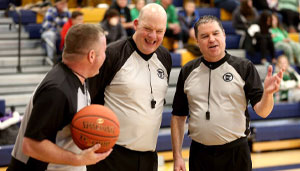One of the biggest debates that has been pushed into today’s youth sports culture is whether athletes are best to specialize in one sport or try their hands at participating in multiple sports. Because of the prevalence, access, and influence of club based sports, we’re seeing more of our high school athletes specialize at an earlier age. In our post-season player surveys, I often read responses from underclassmen who are planning on dropping one sport in order to focus on their “main” sport the next year. As participation rates in most of our sports continue to decline, we try to actively combat this trend by pushing out information to our students.
Advocates of single sport specialization point to the “necessity” of year-round skill development in order to give athletes a chance at becoming good enough to play a sport beyond high school. While this method certainly works well for those who are naturally talented (see Tiger Woods or almost any Olympic gymnast), specialization still isn’t a guarantee for anything. In order to meet the goals of our educational-based programs, we focus on several other aspects of participation in our programs.
The main goal within our department is making sure the students are enjoying their time in our programs; we want them to have fun. If athletes want to play multiple sports, we’re hoping that the adults in their lives are encouraging them to play multiple sports. Too often, the pressure to specialize comes from an adult, either a coach or a parent. If less than seven percent of high school athletes move on to college sports (and only three percent earn an athletic scholarship), we need to focus our programming on the other 93 percent of our participants. If we have 500 participants in our high school, encouraging early specialization is only going to benefit roughly 35 of those athletes, and many of those 35 athletes would have moved on to college sports anyway. Since most athletes prefer multi-sport participation, we want to create a culture that encourages multi-sport participation.
For those athletes who choose to specialize for the potential to advance to or beyond high school, it’s important for coaches and parents to be honest with them. The increased time, cost, and effort commitment is not a guarantee that anything awaits the athlete down the road. Any athlete who fully commits to a sport needs to be comfortable knowing that the end will come at some time, and probably sooner than the athlete was hoping.
There are several detriments for kids who specialize. The first is facing a greater risk of burnout. Kids get bored when they have to do the same thing over and over again. Couple that repetition of the same activity with outside pressure placed on the athlete by adults, and it’s a perfect recipe for burnout. Burnout can be caused by many factors, but it ultimately occurs when athletes feel helpless about their ability to meet external (or internal) expectations.
Another problem that we’re starting to see more and more of is overuse injuries. If tender, growing joints are subjected to the same movements and stress without rest and recovery, those joints are going to get hurt. Pick your favorite sport, and you’ll see that at least one set of joints is more susceptible to injury as a result of those sport specific movements. World renowned-surgeon Dr. James Andrews has spoken multiple times in the past few years about this more recent phenomenon. He focuses his discussion around the increase in Tommy John surgeries (to repair a ligament in the elbow) in younger athletes, specifically baseball players. Certainly the possibility of injury can be reduced through a well designed and implemented training program that incorporates rest time, but many of our club sports are being run by individuals who are have sport-specific knowledge and who are not familiar with periodization or safe training regiments.
One of the biggest issues we face with all kids in youth sports today is the overscheduling and overorganization of sports. Kids who are allowed time to free play – outside of the structure of organized sports – tend to be more creative, have better basic motor skills, learn more social/emotional skills, and find ways to just have fun while playing. Kids who are taking year-round lessons or moving from team to team and miss out on the opportunity to grab some friends, roll out the ball and just play.
The other risk our youth face when involved in year-round organized sports is that of stunted social and emotional growth. When adults are always in charge, kids don’t learn how to communicate with each other, how to problem solve, how to solve disagreements, or how to have fun for the sake of having fun. All of these are important skills that we use in the adult world as well. Aside from that, increased time in one activity naturally leads to decreased time in all other activities. This narrows an adolescent’s social circle and number of experiences outside of the specialized sport.
The last major detriment is the external pressure put on athletes to succeed. Athletes who are encouraged to specialize in a sport for any reason are often placed on a pedestal by the adults around them. Specialization often occurs as a result of coaches or parents who want athletes to “be the best they can be” without acknowledging that there are many paths to that goal. The younger the kids are, the fewer coping skills they have acquired to deal with this kind of pressure.
The many benefits of multi-sport participation are clear for the 93 percent of high school athletes who will not advance to the college level. Similarly, there are tangible benefits for those seven percent of athletes moving on, too. In addition to the athlete’s sport-specific skill level, college coaches want to know how an athlete moves, how an athlete thinks, how good of a teammate the athlete is, how the athlete deals with adversity, and how the athlete competes. All of these can be easier to witness when an athlete is playing a sport that comes less naturally to them.
In addition, there are plenty of cross-sport skills that can be learned in one activity then applied to others. Athletes can learn or enhance their hand-eye coordination, balance, endurance, explosion, communication or athletic agility by participating in a variety of sports. The athletes who are genetically gifted can still benefit greatly from participating in many different sports.
Because the majority of our youth athletes can benefit greatly from multi-sport participation, it is important to create a department philosophy and culture that encourages our students to stay involved in activities.
Mark Rerick
Mark Rerick, CMAA, has been an athletic director since 2006. After spending time splitting duties at other schools as a teacher, coach and principal, he has been the full time athletic director for Grand Forks (ND) Public Schools since 2012.
Most Recent Articles
- nfhs news NFHS Learning Center Delivers 25 Millionth Course
- Track & Field/Cross Country article Effective Communication with Athletes and Coaches
- nfhs news Player Equipment Changes Highlight 2025 High School Football Rules Revisions
- Player Equipment Changes Highlight 2025 High School Football Rules Revisions
- nfhs news Judgment Call on Second Contact Eliminated in High School Volleyball






